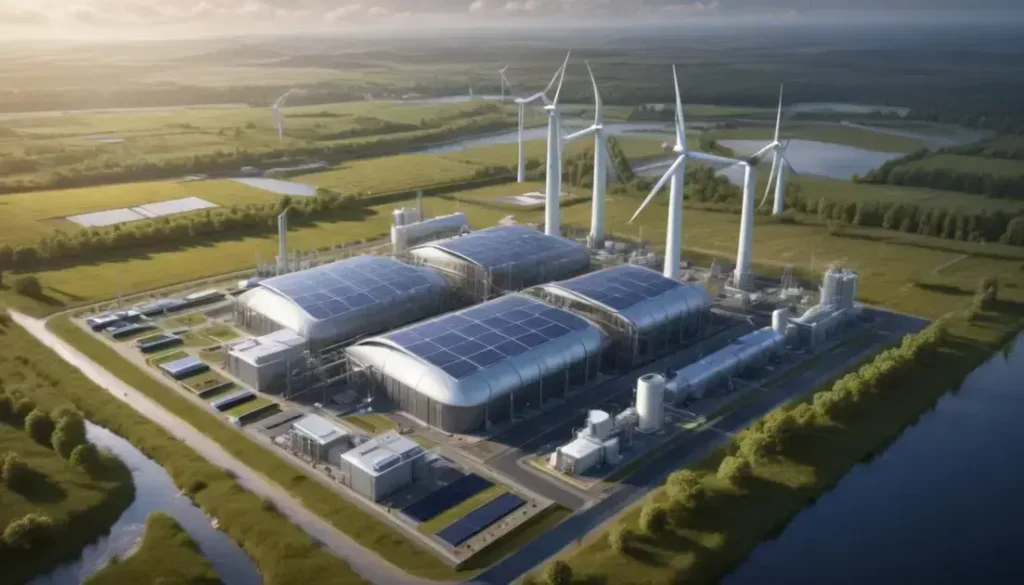A circular economy aims to minimize waste through practices such as recycling, reusing, and remanufacturing products, promoting sustainability and resource efficiency in business operations.
Circularity is reshaping business landscapes. As more companies adopt sustainable practices, understanding its significance is crucial for success. What can Canadian businesses learn from this shift?
Understanding Circularity
Understanding Circularity is essential for businesses aiming to thrive in a sustainable economy. This concept focuses on creating a system where resources are used, reused, and recycled, minimizing waste and reducing environmental impact. By embracing circularity, companies can foster innovation while also meeting consumer demand for sustainable practices.
Implementing circularity involves rethinking product life cycles and embracing sustainability at every stage—design, production, and consumption. Businesses are encouraged to utilize renewable materials and engage in closed-loop production processes, which recycle materials back into the production cycle.
Moreover, adopting circular principles can enhance brand reputation and customer loyalty. Consumers today are more conscious of their environmental footprint and are likely to support brands that align with their values. By showcasing commitment to circularity, businesses distinguish themselves in a crowded market.
It’s also important to note the role of collaboration. Partnerships between businesses and stakeholders, including suppliers and customers, can drive the transition to a circular economy. Through collective efforts, organizations can share resources and knowledge, creating a more resilient supply chain.
The Rise of Circular Economy
The Rise of Circular Economy is reshaping how businesses operate and interact with the environment. This model prioritizes resource efficiency and sustainability by promoting practices that reduce waste and encourage reuse. Companies are increasingly recognizing the need to shift from a linear approach—where products are made, used, and discarded—to a circular framework that values regeneration.
Incorporating circular principles involves rethinking entire supply chains. It encourages businesses to redesign products for longevity, making them easier to repair, refurbish, or recycle. This strategy not only minimizes waste but also can lower costs associated with raw materials.
Furthermore, the rise of consumer awareness is driving demand for sustainable products. A growing number of consumers prefer brands that commit to environmentally friendly practices. Companies that adapt to these market expectations can enhance their reputation and increase customer loyalty.
Innovations such as product-as-a-service models are gaining traction within the circular economy framework. Instead of selling products, businesses offer services that fulfill the same function, allowing them to retain ownership of materials and manage lifecycle effectively. This approach not only extends the lifespan of products but also fosters ongoing relationships with customers, creating value through shared resources.
Impacts of US Tariffs
Impacts of US Tariffs on the circular economy are profound and far-reaching. Tariffs can disrupt supply chains, increase costs, and ultimately affect pricing strategies for businesses. For Canadian companies, this creates a significant challenge as they navigate the complexities of international trade.
Increased tariffs on imported goods can force companies to reassess their reliance on foreign suppliers. As a response, many are turning towards local sourcing, enhancing regional manufacturing capabilities. This shift aligns with the principles of the circular economy by reducing transportation emissions and fostering local economic development.
Moreover, higher tariffs can encourage innovation in product design. Companies are incentivized to create products that are easier to repair, recycle, and reuse, minimizing the need for raw materials and lowering costs. This focus on sustainability resonates with environmentally-conscious consumers, enhancing brand loyalty and market competitiveness.
However, the impact of tariffs also means that businesses must be strategic in their operations. Companies should conduct thorough analyses of how tariffs affect their supply chain and pricing structures. Investing in technologies that enable greater efficiency and sustainability will be essential for remaining competitive in a tariff-impacted market.
Consumer Willingness to Pay
Consumer Willingness to Pay for sustainable products is a key driver in the adoption of circular economy practices. As awareness of environmental issues grows, consumers are increasingly willing to invest in products that reflect their values. Studies show that many shoppers prioritize sustainability and are prepared to pay a premium for environmentally friendly options.
The demand for sustainable goods influences market dynamics, pushing companies to innovate and develop products that minimize environmental impact. By understanding consumer preferences, businesses can tailor their offerings to meet the expectations of eco-conscious customers.
Brands that effectively communicate their commitment to sustainability often see enhanced loyalty and trust from their customers. This relationship is particularly strong among younger generations, who are more inclined to support brands that align with their ethical views. Companies can leverage this trend by clearly showcasing their sustainable practices, such as using recycled materials or implementing fair trade standards.
Moreover, integrating sustainable practices into marketing strategies can also boost sales. When businesses highlight their efforts towards sustainability, they not only attract environmentally aware consumers but also differentiate themselves from competitors. The willingness to pay for sustainability is not just a trend; it represents a fundamental shift in consumer behaviour that businesses must embrace.
Role of AI in Sustainability
The Role of AI in Sustainability is becoming increasingly vital as businesses seek innovative solutions to environmental challenges. AI technologies can analyze vast amounts of data, enabling organizations to make informed decisions that optimize resources and minimize waste. By leveraging AI, companies can monitor their environmental impact more effectively and implement strategies that promote sustainability.
One key application of AI is in the management of energy resources. Smart grids and AI-driven analytics help in optimizing energy consumption, predicting peaks in usage, and integrating renewable energy sources. This not only lowers costs but also reduces greenhouse gas emissions, aligning with global sustainability goals.
Furthermore, AI assists in improving efficiency across supply chains. By analyzing patterns and predicting demand, businesses can minimize excess production and reduce waste. AI models can suggest optimal shipping routes, ultimately lowering carbon footprints in logistics.
In addition, the use of AI in product design fosters the development of sustainable products. AI can simulate how materials behave over time, guiding designers in selecting environmentally friendly materials that maintain high quality and durability. This innovative approach not only benefits the planet but also resonates with consumers who prioritize sustainability in their purchasing decisions.
Challenges in Implementation
Challenges in Implementation of circular economy practices present significant hurdles for many businesses striving to become more sustainable. Transitioning from traditional linear models to a circular model requires comprehensive changes across all operations. A major challenge lies in restructuring supply chains to prioritize resource efficiency and waste reduction.
Another key issue is the need for education and training of employees. Without proper understanding and skills, teams may struggle to implement new sustainable practices effectively. Companies must invest in training programs to ensure everyone is equipped with the knowledge needed for this transition.
Moreover, financial constraints can impede the implementation of circular initiatives. Many businesses face high costs associated with redesigning products, investing in new technologies, or upgrading facilities to support sustainable practices. This financial barrier often discourages companies, particularly small to medium enterprises, from making necessary changes.
There is also the challenge of consumer behaviour and market acceptance. Educating consumers about the value of sustainable products is essential for success. Companies must effectively communicate the benefits of circular practices to encourage consumer willingness to pay more for environmentally friendly options.
Circularity and Supply Chain Resilience
Circularity and Supply Chain Resilience are increasingly intertwined concepts that play a crucial role in sustainable business practices. By adopting circular principles, companies can enhance their supply chain resilience against disruptions. This resilience is vital as businesses face various challenges, including natural disasters, geopolitical tensions, and market fluctuations.
Implementing circular economy practices means companies prioritize resource efficiency and waste reduction throughout their supply chains. This approach not only minimizes environmental impact but also enables organizations to maintain consistent operations in the face of disruptions. For example, using recycled materials can help mitigate resource scarcity and fluctuations in raw material prices.
Furthermore, embracing circularity encourages collaboration among stakeholders. Businesses can build stronger networks with suppliers and partners, fostering an environment of shared knowledge and resources. This connection enhances the adaptability and flexibility of the supply chain, making it easier to respond to unexpected changes.
Moreover, circularity drives innovation in product design and delivery methods. Companies are prompted to think creatively about how products are made and how they can be reused or remanufactured. This not only adds value to their offerings but also promotes sustainable consumption, leading to long-term benefits for both businesses and the environment.
Future of Circular Business Models
The Future of Circular Business Models is promising as businesses increasingly recognize the need for sustainable practices. With a growing emphasis on environmental responsibility, circular models are becoming essential for long-term viability. These models focus on reducing waste through innovative strategies like recycling, reusing, and remanufacturing products.
Advancements in technology will play a pivotal role in shaping these future models. For instance, data analytics and artificial intelligence can optimize resource management, helping companies understand better how to minimize waste while maximizing efficiency. This will allow businesses to adapt quickly to changing market demands and consumer preferences.
Moreover, as consumers become more conscious of their purchases, they are actively seeking products that align with their ethical values. This shift is driving companies to innovate their offerings, creating products designed for longevity and easy recycling. Companies that prioritize sustainability are likely to gain a competitive advantage, attracting a loyal customer base willing to support environmentally friendly practices.
In addition, new policies and regulations are expected to support the transition to circularity. Governments worldwide are beginning to implement frameworks that encourage businesses to adopt sustainable practices. As a result, companies must stay ahead by integrating circular economy principles into their core strategies. This proactive approach will ensure their relevance in the evolving market landscape.
Conclusion and Best Practices
Conclusion and Best Practices for implementing circular economy principles are vital for driving sustainability within businesses. Companies must prioritize integrating circular strategies into their core operations to stay competitive and meet consumer expectations. This includes redesigning products for longevity, utilizing renewable resources, and embracing innovative waste management techniques.
One of the best practices is fostering collaboration among stakeholders. Engaging suppliers, customers, and even competitors can create a network of shared resources, knowledge, and technology. This collaboration enhances the potential for successful circular initiatives and helps businesses navigate challenges more effectively.
Additionally, companies should invest in education and training for their employees. Providing resources and training on circular economy practices increases the likelihood of successful implementation. Empowered teams are more capable of innovating and adopting sustainable practices that align with the company’s goals.
Moreover, employing data analytics can greatly improve decision-making processes. Companies that leverage data to track and analyze resource use can identify areas for improvement and implement changes that lead to greater efficiency. Finally, companies should remain adaptable and responsive to new regulations and market trends in sustainability, ensuring they continuously evolve their practices for lasting impact.
Embracing Circular Economy for a Sustainable Future
Implementing circular economy principles can significantly enhance business sustainability while also addressing environmental concerns. By redesigning products, reducing waste, and fostering collaboration, companies can create systems that benefit both their operations and the planet.
It is essential for businesses to invest in education and training for their teams. This helps everyone understand the importance of sustainability and how to integrate circular practices into daily operations.
Additionally, utilizing data analytics allows companies to track progress, identify improvement areas, and adapt to changing market demands. These strategies are not just good for the environment—they can also lead to cost savings and increased efficiencies.
Ultimately, embracing circular economy practices positions businesses as leaders in sustainability, paving the way for long-term success and a healthier planet for future generations.
Frequently Asked Questions
What is a circular economy?
A circular economy is a model focused on minimizing waste by reusing, recycling, and remanufacturing products to extend their life cycle.
How can businesses implement circular economy practices?
Businesses can start by redesigning products for durability, reducing waste in operations, and collaborating with stakeholders to share resources.
What are the benefits of adopting sustainable practices?
Adopting sustainable practices can lead to cost savings, enhanced brand loyalty, and improved competitiveness in the market.
How does employee training support circular economy initiatives?
Employee training equips staff with the knowledge and skills needed to implement circular practices, ensuring the success of sustainability efforts.
What role does technology play in the circular economy?
Technology, such as data analytics and AI, helps businesses optimize resource use, track waste, and identify areas for improvement in sustainability.
Why is consumer awareness important for the circular economy?
Consumer awareness drives demand for sustainable products, encouraging businesses to innovate and adopt circular practices that meet the expectations of eco-conscious customers.


